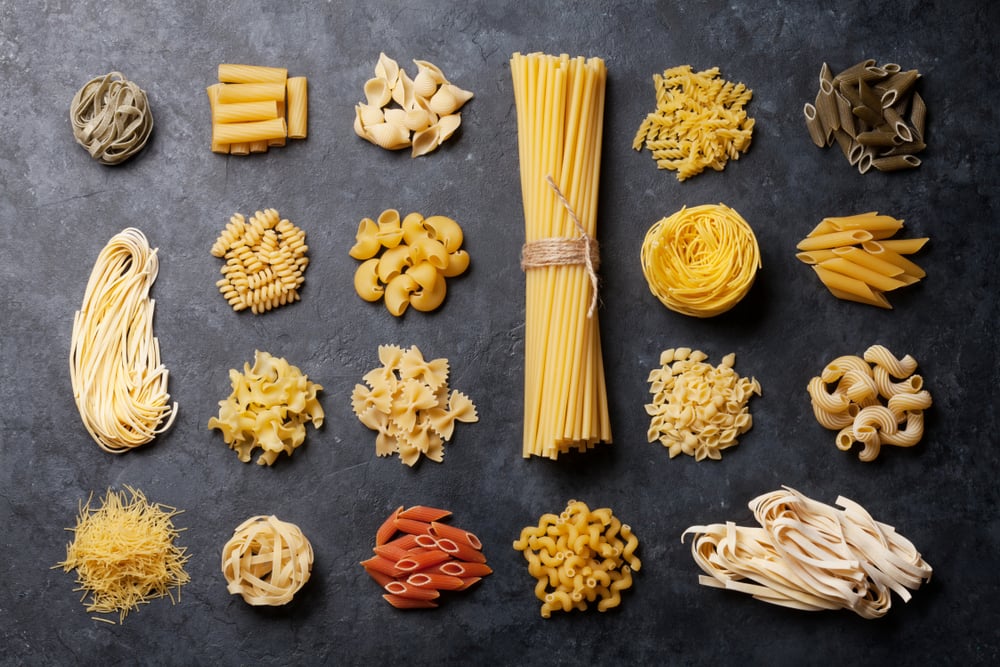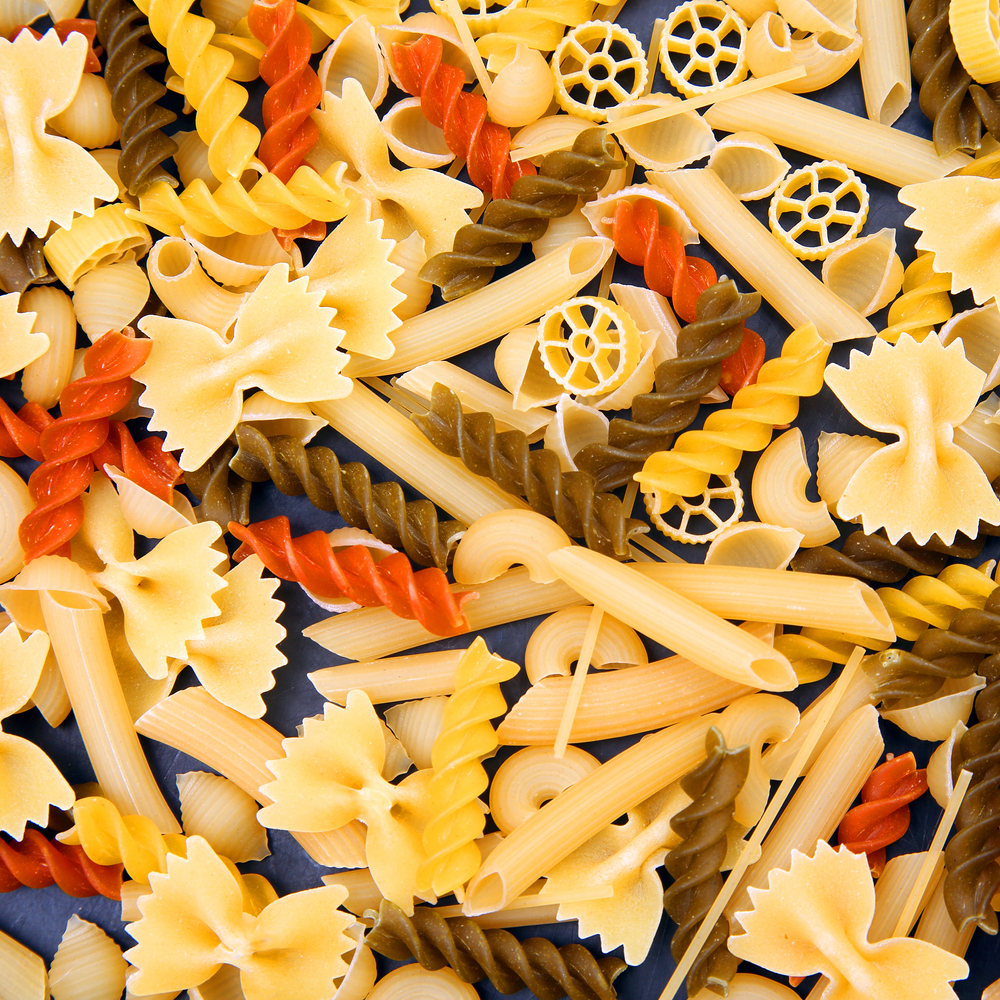After a busy day at work or doing chores around the house, there’s nothing more appetizing and easier than boiling some pasta or noodles and simmering tomato sauce. Italian pasta dishes are a classic, simple dinner. With so many different types of pasta names and noodles, how do you choose which one to use? Let’s dive in and learn all about the different pasta types.
Pasta offers so many possibilities because there are tons of different shapes and sizes. You can serve pasta with tomato sauce, hearty sauce such as meatball spaghetti sauce, or a cheesy and creamy Alfredo sauce. For fun, try experimenting with pairing up different sauces with a variety of different noodle types. Above all, pasta is easy to prepare, and you can experiment to your heart’s content. Pasta is a staple food in many cultures and comes in many different shapes and sizes.

Sure, pasta is easy to make, and who doesn’t love pasta or noodles? However, with the overwhelming variety of different types of noodles, which one do you choose for your new signature dish? Before you get too wild and crazy with your pasta dishes, let’s learn more about the different types of pasta and how they’re prepared.
Types of Pasta
With so many different pasta types, it can be confusing. It helps to group them into a few different categories: long pasta, short pasta, stuffed pasta, sheet pasta, and dumpling pasta. To make long pasta, it can be made with an extruder or hand-rolled. However, many of the short pasta types must be made with extruders to create unique shapes of many of these pasta types.
Long Pasta
With long ribbons and strands of pasta, you can create tantalizing classic recipes such as spaghetti, capellini Pomodoro, and linguine Alfredo. Long pasta shapes work best with thick sauces that have small chunky ingredients (or no chunks at all).

Tagliatelle
Sometimes tagliatelle gets mistaken for fettuccine because it looks so similar. Also, chefs in Italy often refer to this pasta as fettuccine. While both kinds of pasta are flat, tagliatelle has a thicker bite.
Angel hair pasta
Angel hair pasta is as long as spaghetti but about twice as thin. The most important thing to remember about angel hair pasta is that the cooking time is very short. If you overcook this thin pasta, it will lump together.
Spaghetti
Spaghetti needs little introduction because it’s the most popular pasta type in the U.S. Spaghetti and meatballs are the classic way to cook this pasta, or you can make thick and hearty meat and tomato sauce.
Bucatini
Bucatini looks similar to spaghetti, but it has a hole in the middle that gives the noodles hollow centers. Also, bucatini pasta is rounder than spaghetti. Those little holes are perfect for capturing sauce in casseroles and soups.
Vermicelli
For super skinny noodles, look no further than vermicelli. Vermicelli is used in both Asian and Italian cuisine. For Italian recipes, vermicelli is made with semolina flour, and for Asian stir-fry dishes, vermicelli is made with rice.
Linguine
Although linguine is similar to fettuccini, it’s not quite as wide. The two are often used interchangeably because they look similar. Linguine is ideal for seafood pasta dishes, and the ideal sauces for linguine are white wine sauces and cream sauce.
Fettuccine
Picture a flat spaghetti noodle, and you have fettuccini, which is thicker. Because it’s a wide noodle, fettuccine is perfect with creamy Alfredo sauce, thick sauce, and chunky meat sauce.
Pappardelle
Even wider than fettuccine, pappardelle noodles are a ribbon pasta that is amazing with rich and hearty meat-based pasta sauces. In southern Italy and northern Italy, you often see pappardelle served with spaghetti Bolognese sauce or Ragu sauce.
Short Pasta
If you’re cooking a pasta dish that calls for chunkier or thicker sauces with veggies and meat, it’s the perfect time to make a pasta recipe with short pasta. The shapes of short pasta are unique, and they’re made from a mold with an extruder machine. Many of these pasta types are perfect for rich sauces.

Casarecce
If you imagine a tube-shaped pasta that’s open and has rolled edges that aren’t connected, you’ve got an image of casarecce.
Fusilli
Sometimes called corkscrew pasta, fusilli has a unique pasta shape with tons of crevices and grooves for capturing chunks of dressing and sauce. You can toss fusilli with thick marinara sauce, and it’s also a popular pasta for pasta salad.
Campanelle
Campanelle is shaped like a bell-shaped flower with a hollow center. You can use this pasta as a macaroni and cheese substitute.
Rotelli
At one time, Hamburger Helper made a wagon-wheel-shaped pasta mix, so many of us have experienced rotelli pasta, but most of us didn’t know the name of it. Rotelli is perfect for soups, and it also works well for macaroni and cheese.
Elbow macaroni
You’ve probably eaten a lot of elbow macaroni in your life, especially if you love macaroni and cheese. It’s also perfect for craft projects because you can string it up easily. Elbow macaroni is also great in soups and casseroles.
Radiatori
For casseroles and soups, radiatori is perfect. You may have a hard time finding it in the grocery store, but you can easily find it online. Visually, it looks something like a futuristic spiral.
Ditalini
Essentially, ditalini looks like you took some ziti noodles and cut them into small noodles. You’ve probably seen ditalini in minestrone soup, and it’s used to make a pasta Fagioli recipe.
Orzo
Orzo’s not a grain. It’s actually pasta, although you’ll be forgiven if you’ve mistakenly thought it was grain. Orzo looks a lot like rice, and it’s wonderful in pasta salad and soup.
Rigatoni
Although similar in shape and size to penne pasta, rigatoni is not as narrow. It’s also a bit stumper and doesn’t have penne’s slanted edges. Try rigatoni in a butternut squash and pasta recipe.
Ziti
Another pasta that looks somewhat like penne, ziti is hollow and narrow. However, ziti’s edges are straight, and it doesn’t have ridges. Ziti is popular for the beloved baked pasta dish (baked ziti), and it’s also delicious when paired with tomato sauce or olive oil sauces.
Farfalle
The next time you make a pasta salad, consider using farfalle, the cute little bowtie pasta. You can find this in different colors, too. In addition to pasta salad, farfalle is also great with a creamy sauce.
Cavatappi
Do you want something slightly quirky for your favorite macaroni and cheese recipe? With plenty of surface area, the cheese sauce coats cavatappi pasta beautifully.
Orecchiette
This diverse pasta is great with cream sauces because the tiny dips in the centers are magical when it comes to capturing sauce.
Conchiglie
If you like shell pasta, give conchiglie a try. This pasta is based on the Italian word for shell. These pasta shells come in different sizes, from tiny all the way up to jumbo. You can use shells to make macaroni and cheese, and this pasta is also great for meat sauces.
Gemelli
If you take two ropes of dough and twist them together, it will look like Gemelli pasta. However, this pasta is actually one piece of dough, so it’s an edible optical illusion. Try this pasta with pasta salad and leafy veggies.
Rotini
Rotini is another delicious corkscrew pasta, but it has a tighter spiral than what you get with fusilli. However, it still catches all of the yummy sauce wonderfully. Try rotini with creamy sauces or oil-based sauces.
Penne
In addition to macaroni, penne tubular pasta is one of the most beloved short pasta types. The pasta is cylinder-shaped and hollow with slanted edges. The ridges make it perfect for catching sauce. Try this pasta in casseroles and chicken piccata.
Sheet Pasta
Most of us are familiar with sheet pasta because of our experience making lasagna. Sheet pasta is flat and thin.
Lasagna
Lasagna noodles are indispensable when you’re making the popular Italian casserole that’s loaded with a meaty sauce and layers of ricotta cheese and melty mozzarella cheese.
Dumpling Pasta
There’s only one dumpling pasta variety, and it is…gnocchi!
Gnocchi
Gnocchi is unique because it uses the humble potato, along with egg and flour, to create small dense dumplings. Serve the gnocchi with a decadent cream sauce.
Filled Pasta
Have you ever had ravioli? Then you’ve had filled pasta! But ravioli is just the beginning. Filled pasta can be stuffed with cheese, veggies such as spinach, or Italian sauce and ground beef.

Ravioli
Maybe the first time you had ravioli was in that famous can that was loaded up with tomato sauce. We all loved it, right? Well, nothing beats authentic ravioli, so don’t sleep on trying the real deal. Try ravioli with a light sauce because the filling adds so much flavor.
Jumbo shells
Do you want a fun take on stuffed manicotti? Try stuffing cooked jumbo shells with savory meat and tomato sauce. Then, add a layer of mozzarella cheese and stick it in the oven just long enough for the cheese to get ooey and gooey.
Manicotti
If you took penne noodles and super-sized them, you would have manicotti. Baked manicotti with mozzarella cheese and meat sauce is basically the perfect Italian casserole.
Tortellini
If you think tortellini looks like little fluffy donuts, you’re not alone. You can buy pre-made tortellini that’s stuffed with meat and cheese, and it’s ideal for tossing with parmesan cheese and olive oil for a quick and easy dinner.
Mezzelune
In some ways, mezzelune pasta is similar to a potsticker, but it’s a bit flatter. This hand-rolled pasta starts out flat, then it’s cut into ovals that you stuff and punch around the edges.
Cannelloni
Another tube-shaped pasta, cannelloni is similar to manicotti, but it doesn’t have the signature ridges. Cannelloni starts out as sheet pasta, then it’s rolled into neat little tubes. Stuff it with cheese and layer on the tomato sauce.
Specialty Pasta Types
For a healthier pasta option, you can find whole-grain pasta and whole-wheat pasta. Following a gluten-free diet? No problem. You, too, can enjoy pasta. We’ve even seen pasta made from lentils and beans, which adds a nice protein component to a pasta meal.
How Do You Make Dried Pasta?
With so many different types of pasta here in the U.S. alone, it’s hard to imagine that there are hundreds more types around the world. Some of the pasta types that are common in other countries may look similar to pasta you’ve had, but they just have different names. Here in the U.S., there are two ways to make dried pasta: extruded or hand-rolled.
The first method is hand-rolled pasta. Most pasta types are egg pasta and have two basic ingredients: eggs and flour. In some cases, it’s just water and flour. Then, the pasta dough is rolled out and cut into all of the different pasta shape options.
The second method uses an extruder, and this is how most of the pasta you find in the grocery store is made. The person preparing the pasta puts the dough through a machine that cuts different pasta shapes to make unique pasta.
Dry Pasta vs. Fresh Pasta
Which is better: fresh pasta or dried pasta? Making homemade pasta from scratch is fun and delicious, but dried pasta may hold up better if you’re making hearty dishes. A dried pasta noodle holds up better when it comes to bold pasta sauce, and they are also great for cooking dishes such as casseroles.
Storing and Selecting Pasta
If you prepare homemade pasta, you can save the dough that’s been cut and shaped in the refrigerator for up to three days as long as you store it in an air-tight container.
As you select your pasta, keep in mind the sauce you’re going to use. For lighter sauces that are cream-based or oil-based, consider long and thin pasta. A chunky sauce is delicious with the shorter pasta types.

















